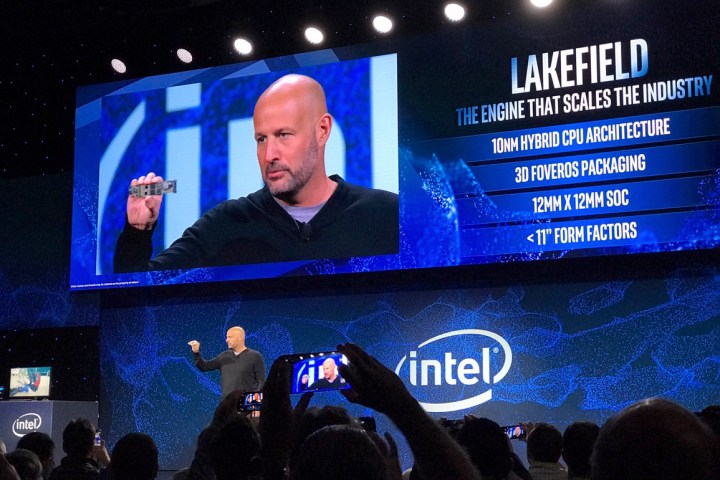
Intel’s CES 2019 press conference was filled with fresh electronic beats, the latest generation in computer processing technology, autonomous cars ready for a bit of assertive driving, and a blip of the company’s vision for the future of computing. Dropping updates on the company’s upcoming 5G wireless strategy, along with its Coffee Lake and Ice Lake CPUs, a lot of new technology will be heading into the hands of consumers and enterprises alike.
- Ice Lake CPUs based on Sunny Cove architecture launch holiday 2019
- Intel 9th generation ‘Coffee Lake’ CPUs for desktop systems
- Lake Field Hybrid CPU, Foveros packaging technology
- Project Athena and the future of computing
- Intel is going big with artificial intelligence
- Expanding the Power of 5G with Snow Ridge
Ice Lake CPUs based on Sunny Cove architecture launch holiday 2019
The Intel CPU is continuing to shrink, and Ice Lake is promising to bring computing down to a 10nm production node this holiday season. The processor promises to include the typical improvements we see with every generation including better battery performance and faster graphics, but it has a few tricks up its sleeves.
More CES 2019 coverage
- Our CES 2019 Hub: The latest news, hands-on reviews, and more
- Everything Nvidia announced at CES, including mobile RTX, the RTX 2060, and more
- HP Omen 15 (2019) gaming laptop: Our hands-on review
- Huawei MateBook 13 hands-on review: A MacBook Air for Windows fans
- Samsung’s new Notebook Odyssey packs next-gen RTX graphics in a thin frame
The new SOC running the Sunny Cove architecture will feature Intel’s DL boost technology, allowing for faster AI computations. Intel notes that the included tech will enable Intel’s CPUs to perform machine learning tasks up to two times faster than a chip without DL boost
Ice Lake CPUs will also include integrated, native Thunderbolt 3 support and Wi-Fi 6 capabilities for the fastest connections via wired or wireless options.
Intel 9th generation ‘Coffee Lake’ CPUs for desktop systems
Last October Intel launched its first collection of ninth generation Coffee Lake CPUs for desktop systems. Today at CES, the company introduced six additional chips that will be joining the family, including the Core i5-9400.
With six cores, a base clock of 2.9GHz, and a boost clock of 4.1GHz, the Core i5-9400 is targeted at, well, just about everyone. Like the Core i5-8400 before it, and the i5-7400 before it, the i5-9400 is a solidly mainstream component that should work for just about everyone.
The first new processors will be available January 2019, with more coming through the second quarter of 2019.
Lake Field Hybrid CPU, Foveros packaging technology
It wasn’t that long ago machines were unable to switch on-the-fly between different graphics solutions, providing an experience that might be powerful, but also took a hard hit on battery life. Intel’s latest project showcasing Lake Field CPUs aims at solving similar issues within processors using a hybrid approach. Packed inside a Lake Field chip is five individual cores — four Atom-based cores for less intensive tasks and a larger fifth core for more power-hungry tasks.
Intel’s Foveros packaging technology helps to enable the new hybrid CPUs with a stacking design. Facilitating the creation of smaller boards and thinner PCs, the Foveros packaging process allows Intel to stack chip technology vertically, reducing the overall physical size of the chip.
Project Athena and the future of computing
Intel stopped taking about Project Athena at their press conference almost as soon as they began talking about it. A new set of industry standards, similar to when Intel introduced the ultrabook, Project Athena is planning on changing the way we compute. Or, at least, that’s what Intel says.
For now, all we know is that Intel’s vision is squarely focused on building hybrid machines that keep us connected, and are adaptable to our daily lives. From the company’s included imagery on-stage, and past comments from the company, we know that Intel sees the physical keyboard as dead with dual screen machines taking the spotlight.
Intel is going big with artificial intelligence
From Intel’s showcase in Las Vegas, we know that the company will be teaming up with Alibaba to create 3D athlete tracking technologies using regular camera data. Viewers and judges of the 2020 Olympics will be able to carefully analyze athlete data and statistics thanks to DL Boost technology found on the company’s Xeon Cascade Lake chipset, in addition to future technology not yet released to enterprise users.
Intel also showcased research coming from MobileEye, an Intel-owned company, focused on creating advanced computer vision solutions for the world of autonomous vehicles. Both Intel and Ordnance Survey, Great Britain’s national mapping agency, will set out to bring higher-precision data to local government agencies and businesses. Additionally, the company has announced how they have begun integrating assertive, yet safe, driving techniques into their autonomous vehicles thanks to machine learning.
Expanding the Power of 5G with Snow Ridge
Intel is breaking into a new market with their Snow Ridge chipset, producing telecom equipment to enable faster 5GB performance for mobile devices. A business that Intel had previously steered clear of, beyond modem production, the company now confidently states they will have over a 40 percent stake within by 2020. Developing new hardware designed and inspired by existing server technologies, Intel will be shrinking down boards to produce the cellular phone equipment, hopefully ushering in the next wave of mobile broadband technology.
Editors' Recommendations
- Intel is killing the nanometer, and good riddance
- Intel’s 14nm node is finally dead, and we can all breathe a sigh of relief
- Intel 10th-gen Ice Lake CPUs: Everything we know so far
- Why Intel teased three products at CES 2020, but didn’t really announce any
- Intel announces Tiger Lake processors, with double the graphics performance


